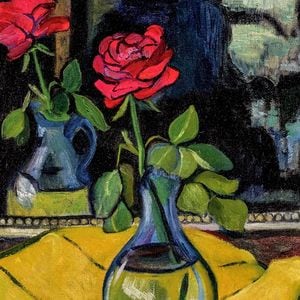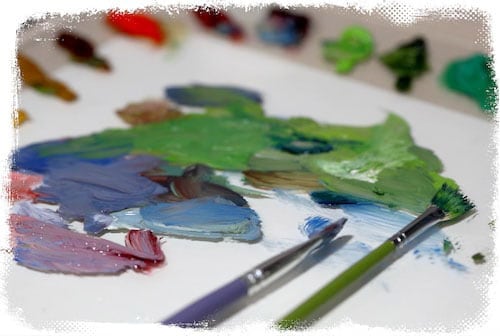
Suzanne Valadon
Suzanne Valadon
1 to 30 out of 142 items
1 to 30 out of 142 items
Suzanne Valadon is a French painter who lived from April 7, 1938, until September 7, 1938. Artist Valadon made history in 1894 when she was accepted as a member of the exclusive Société Nationale des Beaux-Arts. Her son, the artist Maurice Utrillo, was also born to her.
A significant portion of Valadon's life, close to 40 years, was dedicated to her artistic practice.
Her sketches and paintings, such as Joy of Life (1911), depicted mostly feminine nudity, female portraits, still lifes, and landscapes. She didn't go to school for it and was never one to follow the rules.
She posed for many famous painters. Suzanne Valadon (1885) by Henri de Toulouse-Lautrec, Dance at Bougival (1883), and Dance in the City (1883) by Pierre-Auguste Renoir are only a few examples of the many works in which Valadon appears.
At age 15, Valadon started his career as a model in Montmartre, France, in 1880.
Over a decade, she posed for painters such as Berthe Morisot, Pierre-Cécile Puvis de Chavannes, Théophile Steinlen, Pierre-Auguste Renoir, Jean-Jacques Henner, and Henri de Toulouse-Lautrec.
After working as a model under the name "Maria," Toulouse-Lautrec gave her the moniker "Suzanne" about the biblical account of Susanna and the Elders because he believed that she showed a specific fondness for working with more seasoned artists.
After two years of dating Toulouse-Lautrec, she attempted suicide in 1888, ending their relationship.
Valadon aided her art education by witnessing the processes of the painters for whom she posed.
Those who knew her described her as "extremely focused," "ambitious," "rebellious," "driven," "self-confident," and "passionate," among other traits.
Edgar Degas became acquainted in the early 1890s after being captivated by her actual line drawings and beautiful paintings. He showed his support for her by buying some of her artwork. Until his death in 1917, she was one of his closest companions. Heather Dawkins, an art historian, felt that Valadon's background as a model lent credibility to her depictions of naked women, which she felt were less idealized than those of the male post-impressionists.
Although the 1880 artwork by Morisot of Valadon as a tightrope walker came first, the 1883 painting by Renoir Dance at Bougival (the same year she posed for Dance in the City) is the first work of art most people associate with Valadon.
Her second portrait by Renoir, titled Girl Braiding Her Hair, was painted in 1885. His 1885 picture Suzanne Valadon is a profile of the artist's subject. Valadon hung out at Paris's drinking establishments with her other artists, inspiring Toulouse-oil Lautrec's painting The Hangover.
Artists like Edgar Degas and Pierre-Auguste Renoir, who were working simultaneously as Valadon, praised her work and regarded her as a peer. Juried art shows and professional organizations both accepted her position. She was the epitome of the free-spirited, avant-garde bohemian lifestyle.
The charcoal and pastel self-portrait that Valadon created in 1883 is his first dated and signed work.
From 1883 through 1893, she mostly created sketches, but in 1892, she also started painting. Her son, mother, and niece were among her first models.
In 1896, Valadon committed himself entirely to his art.
Her still lifes, portraits, floral arrangements, and landscapes all feature bold compositions and vivid color palettes. However, she became famous for her bare breasts. Her paintings of realistically naked bodies caused a stir in the art world since they went against the prevailing conventions of the time.
Twelve etchings by Valadon depicting ladies at different points in their grooming routines were shown in an exhibition held by art dealer Paul Durand-Ruel in 1895.
She eventually began often showing at the Paris gallery Galerie Bernheim-Jeune. In 1894, Valadon could finally display his work at the prestigious Salon de la Nationale. There was intense rivalry for a limited number of spots.
Starting in 1909, she showed in the Salon d'Automne, then in 1911 at the Salon des Independants, and finally in 1933 at the Salon des Femmes Artistes Modernes.
Degas was the first collector to buy one of her drawings, and he also connected her with other patrons like Paul Durand-Ruel and Ambroise Vollard. The technique of soft-ground etching was another one of Degas's lessons to her.
When Valadon married the wealthy banker Paul Mousis in 1896, she could devote herself entirely to her painting.
As early as 1909, she shifted her focus from drawing to painting.
Her first, more ambitious oil paintings for the Salon dealt with sexual delights. They were among the earliest instances of modern art in which a man was shown as the object of a woman's desire in a manner comparable to the idealized depictions of women by male painters. Notable works included at the Salon include Adam and Eve (Adam et Eve, 1909), Joy of Life (La Joie de vivre, 1911), and Casting the Net (Lancement du filet, 1911). Excluding donated or destroyed works, Valadon completed about 273 sketches, 478 paintings, and 31 etchings throughout her lifetime.
During her lifetime, Valadon achieved widespread renown, particularly in her latter years as a professional.
In addition to the Metropolitan Museum of Art in New York, her works may be found in the collections of the Centre Georges Pompidou in Paris and the Museum of Grenoble in France.
The work of Valadon shows that she was not limited to a single style; instead, it has elements of both Symbolism and Post-Impressionism.
She preferred the more permanent qualities of oil paint, oil pencils, pastels, and red chalk over the more fluid qualities of ink and watercolor. Many of the figures in Valadon's paintings are defined by strong black lines that stand out against the vibrant colors and free brushwork.
Even now, Valadon's self-portraits, portraits, nudes, landscapes, and still lifes have nothing in common with the fashions and fads of contemporary academic painting.
Valadon's muse typically reimagines classic master motifs, such as naked ladies in the bath or lounging around the home. She favored depicting women from the working class. According to art historian Patricia Mathews, Valadon's experience as a working-class model and her background in the working class likely informed her closely about the familiar study of these women and their bodies. In this way, she was distinct from the upper-middle-class French painters Berthe Morisot and Mary Cassatt, who also focused on female subjects in their work but "remained well within the confines of propriety in their subject matter." While her lack of formal education may have left her less impacted by academic traditions, Valadon's marginalization enabled her to access the modern male-dominated sphere of art via modeling. She is known for using a unique approach in her depictions of naked women. Through her realistic portrayal of unidealized and self-possessed women who are not overtly sexualized, she defied standard representations of women, emphasizing class trappings and their sexual beauty. Throughout her career, she also created several naked self-portraits, some of which showed her aging body realistically.
For Valadon, the composition of a portrait was more important than any particular technique, even if that method was as simple as painting eyes with emotion. From her latter period, Blue Room (1923) is characterized by a more vibrant color palette and an increased focus on ornate backdrops and patterned fabrics. Valadon gave birth to her son Maurice Utrillo in 1883 when she was 18. While Valadon was off doing her modeling thing, her mother took care of Maurice. Although the exact paternity of Maurice was never revealed, Valadon's buddy Miquel Utrillo later filed paperwork acknowledging Maurice as his son.
Valadon's relationship with composer Erik Satie was brief, lasting from 1893 to 1894 when the two shared an apartment on the Rue Cortot. He referred to her as his "Biqui," and his feelings for her completely consumed him. The breakup saddened him for the next six months.
Valadon wed stock merchant Paul Mousis in 1895. She was with him for 13 years, when they shared a Parisian flat and property in the suburbs. Valadon had an affair with the painter André Utter, a friend of her son's who was 23 at the time, beginning in 1909. She used him as a model, and he ended up in the role of Adam in her painting Adam et Eve from that same year. They officially split up in 1913. It wasn't until 1914 that Valadon finally tied the knot with Utter. Utter was in charge of both her and her son's professional lives. Valadon and Utter were a married artistic duo that had joint exhibitions until the couple's divorce in 1934 when Valadon was approaching seventy. They remained together until her death and are now resting in Paris's Saint Ouen cemetery.
At the age of 72, Suzanne Valadon passed away on April 7, 1938, from a stroke. She was laid to rest in Section 13 of the Cimetière de Saint-Ouen in Paris. Those who knew her well, such as André Derain, Pablo Picasso, and Georges Braque, paid their respects during her death.
Most paintings Suzanne Valadon did are about Still life, Nude, Portrait, People, and other subjects.
Famous Suzanne Valadon period artists include Edvard Munch (Norwegian, 1863 -1944), Claude Monet (French, 1840 -1926), Pierre Bonnard (French, 1867 -1947), Henri Lebasque (French, 1865 -1937), Édouard Vuillard (French, 1868 -1940), Mary Vaux Walcott (American, 1860 -1940), Frederick Childe Hassam (American, 1859 -1935), Gustave Loiseau (French, 1865 -1935), Sir John Lavery, R.A. (Irish, 1856 -1941), Alexei von Jawlensky (Russian, 1864 -1941), Armand Guillaumin (French, 1841 -1927), Ilia Efimovich Repin (Russian, 1844 -1930), and others.
Get inspired by the most famous paintings of Suzanne Valadon. Pick your favorite, and one of our talented artists will make a copy just like the original, making it a unique gift or piece of art for your home. If you can't find a specific Suzanne Valadon, contact us for a price quote.






























